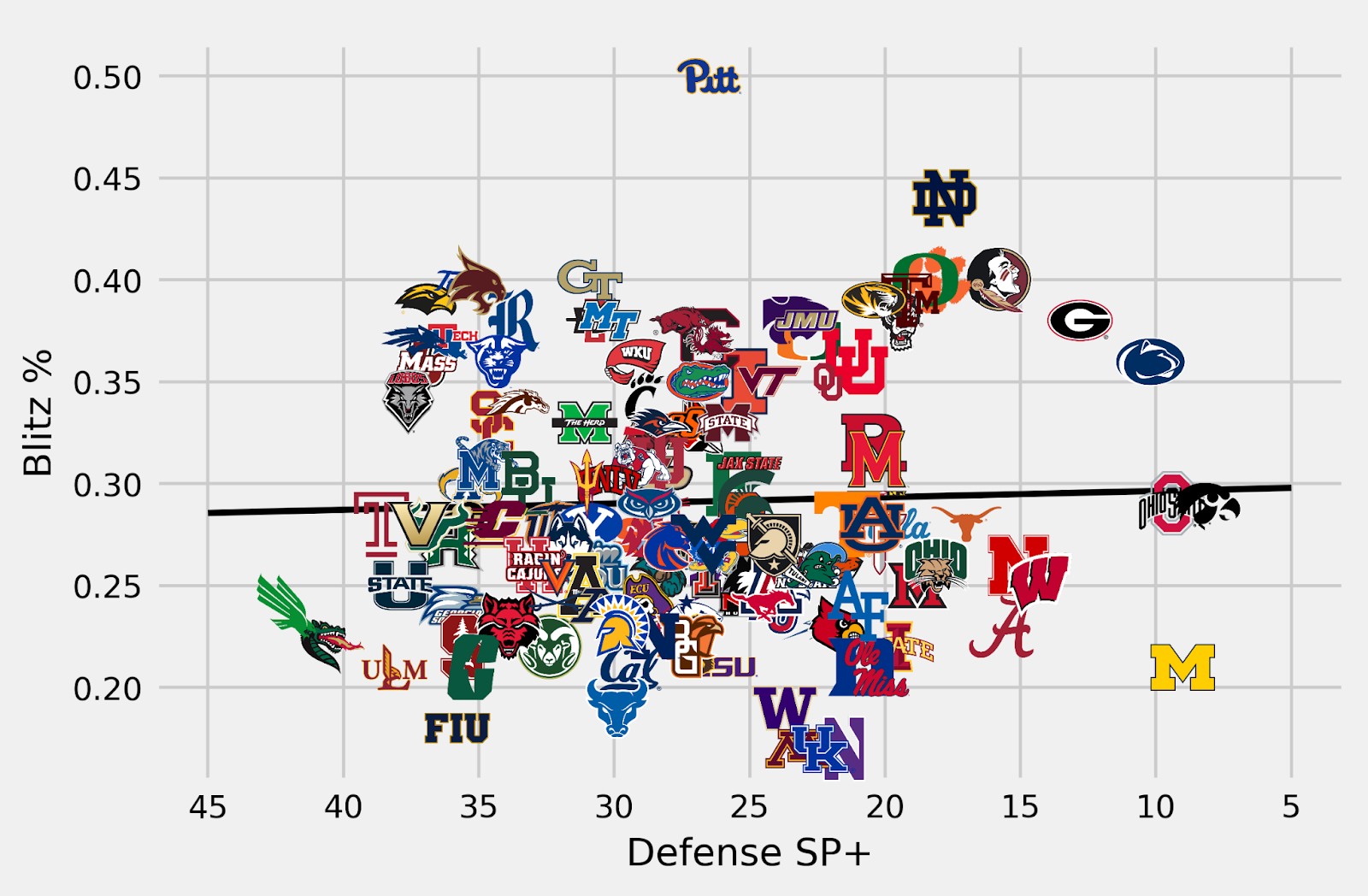NOTE: Following Hudl’s acquisition of Statsbomb, its football platform is now called Hudl IQ. Learn more about the acquisition here.
Last week I used Hudl IQ data to look at variations in formation, personnel, and motion usage on offense. This week I am turning my attention to the defense. Similar to what we do for offensive formation, the Hudl IQ data science team has built models that use player location tracking data to classify fronts, blitz, and coverage type. In this article I will use the data from these models to examine defensive philosophies from 2023, focusing on blitz and coverage type, to try and find teams to keep an eye on for this season as we move past a lot of the week one and two FCS games and into the conference schedules.

I plotted every team's blitz rate against their man coverage rate and immediately some outliers stood out. When you play Pitt you better be ready to handle pressure and win individual matchups because Pat Narduzzi brings extra players like no one else in the country and he trusts his secondary to hold up.
Notre Dame is another blitz and man heavy team. After two games the Irish are playing in a similar fashion to last season with a 43.9% blitz rate and a 60.1% man coverage rate.
Ryan Walters left his job as defensive coordinator with Illinois to become the head coach at Purdue in 2023. His influence can be seen on both as they employ a similar philosophy of above average, but not outlier, blitz rates with a whole lot of man coverage.
I was interested to see where Penn State and Duke stood with Manny Diaz leaving State College to take the head job in Durham. He had an elite defense at Penn State last season as the Nittany Lions by our numbers had the third highest havoc rate (32.2%) and highest pressure rate (30.6%). Their philosophy was to blitz and play man above average rates, 36.2% and 46.5% respectively. Duke on the other hand employed the opposite strategy with a low blitz rate (21.4%) and favoring zone over man coverage (28.6%). Two games into the 2024 season and The Blue Devils are taking after their new head coach with an increase in blitz rate to 39.7% and a man coverage rate of 36.8%. In their first game against Elon they blitzed 43.8% of the time and ran man 46.9% of plays. For Nittany Lions fans, new defensive coordinator Tom Allen’s defense at Indiana blitzed at a 30.9% rate and ran man 38.8% of the time. Two games into the 2024 season and Penn State blitz and man rates a hewing towards the numbers last season compared to Allen’s previous numbers, 38.0% blitz and 53.5% man rates respectively.
The Kentucky Wildcats of 2023 may be the ultimate bend but don’t break defense as they like to drop into zone coverage and rely on their defensive front to generate any pressure. I expected there to be outliers on the more aggressive top left side of the chart but to see Kentucky that isolated in their style I found to be interesting.
Another interesting team was James Madison. The Dukes blitzed at a high rate (37.9%) but used man coverage at a lower rate (25.5%) than similar blitzing teams. Head coach Curt Cignetti and defensive Coordinator Bryant Haines have both moved on to Indiana in the same roles. In week one vs FIU the Hoosiers blitzed at a 37.8% rate and ran man coverage at an 18.9% rate, so Cignetti and Haines have brought a similar philosophy over to the Big Ten so far.
Scheme and Performance
I wanted to look beyond just playing styles and incorporate some performance data to see how philosophies relate to team performance. I took Bill Connelly’s SP+ defensive ratings, where a lower rating is indicative of a better defense, and plotted it against our man coverage and blitz rates.


There is a slight positive correlation between defensive SP+ and both man coverage and blitz rate, and I do mean slightly, the R2 was 0.001 for both. The question of whether defenses are good because they blitz and play man or if they blitz and play man because they are good is going to depend a lot on the personnel available to the defensive coordinator, as well as their own philosophy.
We can see this by looking at the four Big Ten teams that sat atop Bill’s defensive ratings. Michigan (2nd) and Penn State (4th) had comparable defensive ratings but achieved them through divergent strategies. Penn State was a heavy blitz and man team while Michigan was a low blitz zone team. We should see an increase in blitzing this year for Michigan as Wink Martindale takes over. Martindale’s Giants defense blitzed at a 33.3% rate in the NFL last season. Meanwhile, Iowa (1st) and Ohio State (3rd) had good defenses while blitzing and playing man at roughly median rates.
